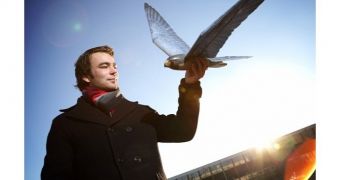You would think that making a flying contraption with the sole purpose of scaring actual, living birds would be cruel, but this could become the main reason why birds rarely crowd airports. Clear Flight solutions has just unveiled its latest such bird.
It is a peregrine falcon, although it doesn't quite look like one, at least not from up close. It lacks an actual neck, for one.
If you squint, you could probably make a case for it being a cross between an actual falcon and a sparrow. It's too large to qualify as the latter though, and that's the whole point.
When it gets high enough and soars through the sky with its wings fully outstretched, it looks just like an actual bird of prey, which is what scares other airborne animals.
The latest “robird” from Dutch company Clear Flight Solutions, the Peregrine Falcon is a bit unusual, more unusual than the others at least.
It has been made by means of 3D printing technology, which is why it is more realistic than any bird with a retractable propeller.
Admittedly, the bird is still a bit stiff, but that can't really be helped. Besides, it's enough that the thing doesn't need to flap its wings that much when it reaches the required altitude.
The bird still needs to be remote controlled, lest they mimic actual falcons and smash into planes during takeoff and landing.
Nevertheless, the folks at Clear Flight Solutions believe that, eventually, they will be able to create self-guided models that can avoid such collisions. After all, large, bulky, metal tubes with wings are pretty hard to miss by most motion sensors. It's the software meant to interpret and respond to the data provided by those sensors that will prove tricky.
That, and implementing an accurate and quick enough steering system. Most likely Clear Flight Solutions will make a few more in-depth studies into the anatomy of birds and their wings before they pull off their long-term goal.
Robirds aren't going to be used just for airplanes, but for places like waste management facilities, where wild birds peck at garbage more than they should. Still, it's airports where flocks of birds can be the most troublesome, so that's the current focus.
We may or may not hear about other robotic birds sooner or later. We'll try to keep an eye out for them and other such animals. It wouldn't do for only the designs of people involved with military research started to get attention.

 14 DAY TRIAL //
14 DAY TRIAL //